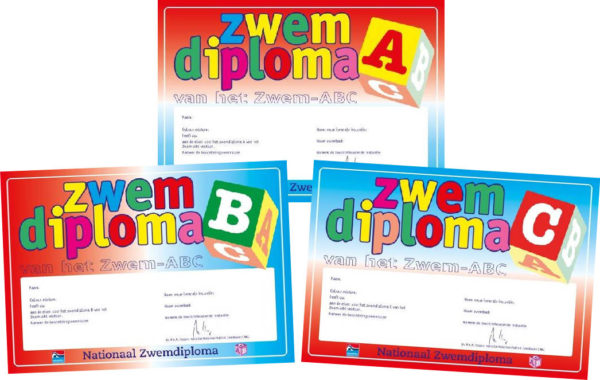Children’s swimming in the Netherlands is a BIG DEAL. It is a big deal for anxious parents shelling out fees and schlepping to (twice-) weekly lessons. A big deal for the kids (for many their first “exams” and for some big rewards in the form of presents for passing) and a big deal commercially.
Necessity and Culture
With so much water about in the Netherlands, many people see it as a necessity that children learn to swim, and until a few years ago, it was part of the curriculum in elementary schools. Now, due to budget cuts, parents are paying themselves to have lessons outside of school. Of course, it is a good (safety) skill to have in general, but it also provides them with a cultural skill. There are many activities for children on the water where at least Diploma A (more of that later) is required. Swimming pools require those without diplomas to wear arm bands (not popular with the bigger kids as you can imagine) and many kids’ parties are held at swimming pools. Also, it does allow for a more relaxed vacation if the kids can swim.
Diplomas
The big test is Diploma A. Children who pass this test and acquire the coveted piece of paper can go to swimming pools and not have to wear arm bands, and as a parent, you can be confident that they will be able to manage on their own (supervision is, of course, always required!) in a regular swimming pool. To obtain this diploma, children need to be able to show the basic strokes (breast and back stroke and breast and back-crawl), be able to float, swim a length in shorts, T-shirt and shoes and swim under water through a gap in a tarpaulin. Also note that Diploma A can be celebrated in a big way, often with grandparents attending, and gifts, cake, etc., and the children take their certificate into school for “show and tell”.
Most parents, however, also like their children to obtain Diploma B. This consolidates the strokes learnt, requires a longer swim underwater, a dive and wearing long sleeved T-shirt , long trousers and shoes. Once obtained, you can be confident your child is a competent all-round swimmer.
Diploma C is a little more of everything (including a rain coat over the clothes), a little harder work and a completion of the standard ABC diploma series.
In addition, “Zwemvaardigheid” (=swimming competency) diplomas can be obtained at different levels (I, II, III), or for different skills, e.g., snorkelling.
How to pay
Some swimming pools/schools offer a fixed fee for AB or ABC. Some offer a discount for, say, 20 lessons at a time. Some you pay by term. Check out what works best for your family and finances. Some schools let you catch-up on missed lessons; some you pay whether you turn up or not.
Note that if you are on low income/income support, help may be available from your local “gemeente” to fund a certain number of lessons. There are strict criteria though, including the age of the child.
What age to do it at
Some people advocate “the younger the better”, starting with parent and baby swimming when the littl’uns are 6-8 weeks old. Others say that children don’t have the motor, listening and processing skills necessary until they are 5 or 6 years old. All advocate starting way before secondary school.
Generally, people seem to start somewhere between 4 and 7 years old.
Which method to choose
There are various methods available:
- In a pool that starts off really shallow. The children do not wear floats. As the lessons and the child progress, the pool becomes deeper and deeper (either by moving the floor or by moving to a deeper area of the pool). Advantages: the children learn to rely on their own bodies and not on floats. Disadvantages: it takes quite a while for the children to actually feel they are really swimming.
- In a pool where the child cannot stand, either with a series of floats that are reduced as the child progresses or with a flotation suit with in-built floats that are removed as the child progresses. Advantages: the children are “swimming” straight away, giving a sense of achievement. Disadvantages: the children are reliant on floats and these can be uncomfortable/get in the way of the strokes/the child.
- Then there is the choice of large pool vs small pool; teacher in the water or on the side; parents allowed to attend/watch always or only once a term; large groups vs small groups vs private lessons; twice half an hour a week vs one lesson of one hour per week. Also there are pools/schools/lessons that specialise in children with special needs (physical/psychological/emotional).
Most places will allow you to at least watch a lesson before you decide what sits most comfortably with you and/or what you think will be best for your child. At some places, you can also pay for or get a free “proefles”, so the child can just join in for one lesson and “taste” to see if it will suit.
Whichever method or pool you choose, it will be up to you and your child to put in the attendance and the hard work, as well as having a lot of fun with it. Don’t forget to take them swimming once in a while so they don’t lose those hard-earned skills!
 +31 (0)50 367 71 97
+31 (0)50 367 71 97  info@connect-int.org
info@connect-int.org
